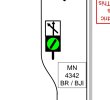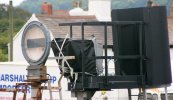No, I don’t think they were considered repeaters. I’ve never worked on any installations like this. Co-acting is I think the term that would apply.
In mechanical interlocking, a distant signal had its own lever and hence it’s own interlocking. And most mechanical box worked signals (semaphore signals and colour light signals) were not fitted with a number/ID plate. Regardless, they were always identified by the lever they were worked by.
However, as electrical and electro-mechanical technology allowed power signal boxes to control much larger areas, in two aspect signal areas, much of the control circuitry for a “distant” or colour light repeater was common with that of the section (“stop”) signal. Further, no independent control to the signaller was provided for colour light “distant” repeater signals. Hence the term repeater, and hence it having the same number as the stop signal, just with a suffix of ‘R’ being added.
A banner also shares much of the circuitry with the signal it’s repeating, so again, it had the same number as that of the main signal, and, depending on where you were, and what year it was, it had a suffix of either ’R’, ‘P’ or ‘BR’.
The only real time that there was any confusion, would be in the rare situation of a two aspect colour light signal needing a banner, but which also had a colour light repeater/distant.


